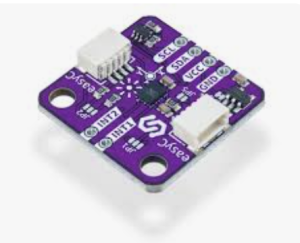
A gyroscope sensor is a critical component in modern electronics, enabling the measurement of angular velocity (rotational speed) around one or more axes. It plays a vital role in orientation detection, motion tracking, and stabilization across industries, from consumer electronics to aerospace. This article explores the history, working principles, types, applications, specifications, and future trends of gyroscope sensors.
Table of Contents
ToggleHistorical Background
The concept of the gyroscope dates back to 1852, when French physicist Léon Foucault invented a mechanical gyroscope to demonstrate Earth’s rotation. Early gyroscopes relied on a spinning wheel or rotor mounted in gimbals to maintain orientation due to the conservation of angular momentum. These mechanical systems were foundational in navigation, particularly for ships and aircraft. The 20th century saw advancements with the development of MEMS (Micro-Electro-Mechanical Systems) gyroscopes, which miniaturized the technology for consumer use.
Working Principle
A gyroscope operates based on the Coriolis effect (for MEMS) or the principles of angular momentum (for mechanical systems).
Key Concepts:
- Mechanical Gyroscopes: A spinning rotor resists changes in orientation due to angular momentum. When the device rotates, the rotor maintains its axis, allowing measurement of the rotation angle.
- MEMS Gyroscopes: These use vibrating structures (e.g., tuning forks). When rotated, the Coriolis effect induces a secondary vibration perpendicular to the initial motion, which is measured as a change in capacitance or voltage to determine angular velocity.
Types of Gyroscopes
1. Mechanical Gyroscopes
- Use a spinning rotor in gimbals.
- High accuracy but bulky and power-hungry.
- Applications: Aviation, maritime navigation.
2. MEMS Gyroscopes
- Silicon-based microfabricated sensors.
- Compact, low-cost, and energy-efficient.
- Applications: Smartphones, drones, gaming controllers.
3. Fiber Optic Gyroscopes (FOG)
- Use interference of laser light in coiled optical fibers.
- No moving parts; high reliability.
- Applications: Aerospace, military guidance systems.
4. Ring Laser Gyroscopes (RLG)
- Measure phase shifts in laser beams traveling in opposite directions.
- Extreme precision but expensive.
- Applications: Commercial aircraft, spacecraft.
5. Hemispherical Resonator Gyroscopes (HRG)
- Use a vibrating hemispherical shell.
- High durability and long lifespan.
- Applications: Satellites, deep-space probes.
Applications
- Consumer Electronics
- Smartphones: Screen rotation, AR/VR head tracking, gesture control.
- Gaming: Motion-sensitive controllers (e.g., Nintendo Wii).
- Aerospace & Defense
- Inertial Navigation Systems (INS): Autonomous guidance for aircraft and missiles.
- Drone Stabilization: Ensures steady flight and orientation.
- Automotive
- Electronic Stability Control ( ESC): Prevents skidding.
- Autonomous Vehicles: Enhances navigation accuracy.
- Robotics
- Balance & Mobility: Used in bipedal robots and industrial arms.
- Healthcare
- Surgical Robots: Precision movement tracking.
- Wearables: Monitors physical activity and posture.
Key Specifications
- Sensitivity: Degrees per second (dps) per output unit (e.g., mV/dps).
- Range: Maximum measurable angular velocity (e.g., ±2000 dps).
- Bandwidth: Frequency range of detectable motion.
- Noise: Measured in dps/√Hz; affects low-speed accuracy.
- Drift: Gradual deviation over time, requiring calibration.
Advantages vs. Limitations
| Advantages | Limitations |
|---|---|
| Real-time motion tracking | Drift errors require recalibration |
| Compact size (MEMS) | Temperature sensitivity (MEMS) |
| Low power consumption | High-precision models are costly |
| High reliability (FOG, RLG) | Mechanical wear in traditional designs |
Future Trends
- Miniaturization: Smaller MEMS sensors for wearables and IoT devices.
- Sensor Fusion: Integration with accelerometers, magnetometers, and AI for improved accuracy.
- Quantum Gyroscopes: Emerging tech using cold atoms for ultra-precise measurements.
- Energy Harvesting: Self-powered gyroscopes for remote applications.
Troubleshooting Common Issues
- Drift: Regular calibration or use of sensor fusion algorithms (e.g., Kalman filters).
- Temperature Effects: Employ temperature compensation circuits.
- Noise Reduction: Signal processing techniques or higher-quality sensors.
Comparison with Accelerometers
While accelerometers measure linear acceleration, gyroscopes track rotational movement. Combined in Inertial Measurement Units (IMUs), they provide comprehensive motion data.
Conclusion
Gyroscope sensors are indispensable in today’s technology, enabling innovations from smartphones to autonomous systems. As advancements in MEMS and quantum technologies continue, their accuracy and applications will expand, solidifying their role in the future of navigation, robotics, and beyond.
- Everything You Need To Know About Limit Switch - May 21, 2025
- Everthing You Should Know About Rheostat - May 20, 2025
- Everything You Need To Know About Reversing Contactor - May 19, 2025






